The fig tree is native to subtropical regions. Originally, it was cultivated mainly in warm Mediterranean countries like Spain, Italy, and Greece. Later, varieties were developed that thrive in temperate climates and, with proper care, can withstand temperatures as low as -20°C.
There are several methods of propagating figs, but the most popular is cuttings. This technique allows for a large quantity of planting material that roots quickly and retains the characteristics of the parent plant. Read on to learn how to propagate figs from cuttings at home.
Table of contents
Can You Grow and Propagate Figs at Home?

Growing figs at home is entirely possible. More and more gardeners are cultivating this plant on their windowsills, as the fig tree is low-maintenance and easy to care for indoors.
The fig tree is a type of ficus. It has a beautiful, branching crown with large, lobed leaves, making it an attractive ornamental plant even without flowers or fruit.
During flowering, the plant produces large blooms resembling tea roses but with more stamens. It bears delicious dark-purple fruits.
To ensure flowering and fruiting indoors, it’s essential to choose the right variety. Self-pollinating cultivars (such as ‘Brown Turkey’, ‘Brunswick’, or ‘Petite Negra’) are ideal, as varieties requiring pollination may not produce fruit indoors.
For reliable fruiting, vegetative propagation is best. Seeds often produce wild figs that may fruit late or not at all.
Note: Indoors, fig trees typically grow up to 1.5 m tall (depending on pot size). A mature plant can produce up to 100 fruits per year.
Advantages of Propagating Figs from Cuttings
Most gardeners prefer propagating fig trees through cuttings. The benefits of this method are clear:
- It provides a large amount of planting material. Pruned branches can often be used, making this method more efficient than layering.
- Cuttings produce flowering plants faster than seed-grown trees.
- Vegetative propagation preserves the parent plant’s characteristics.
- Fig cuttings root quickly and are easy to handle.
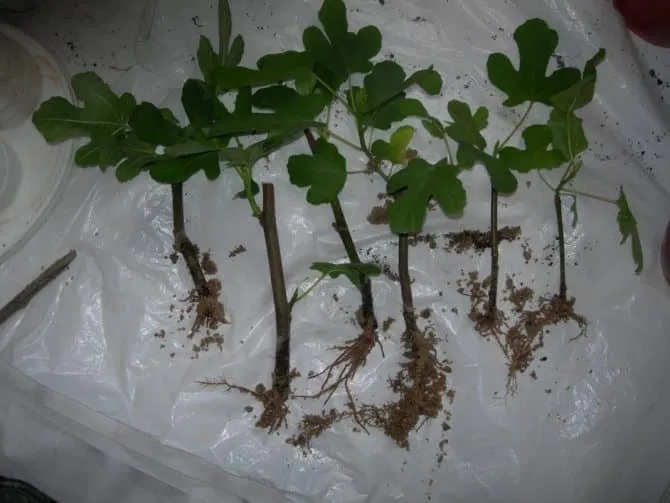
Best Time for Propagation
To ensure successful rooting, choose the right time for taking and planting cuttings. Possible options:
- Spring. Green cuttings are best taken in early spring before buds open (late February to early March). These can be rooted immediately.
- Autumn. Hardwood cuttings are collected in autumn but are only rooted the following spring.
- Summer. Figs can also be propagated in summer, though cuttings may root less reliably. If taking summer cuttings, do so in the early morning or evening to avoid heat stress.
Types of Cuttings
Figs can be propagated using both green and hardwood cuttings. Each type requires slightly different handling.
In both cases, select a healthy, fruit-bearing parent plant to ensure the new trees will also produce fruit.
Inspect the tree for signs of disease or pests. If any issues are found, delay propagation until the plant recovers.
Hardwood Cuttings
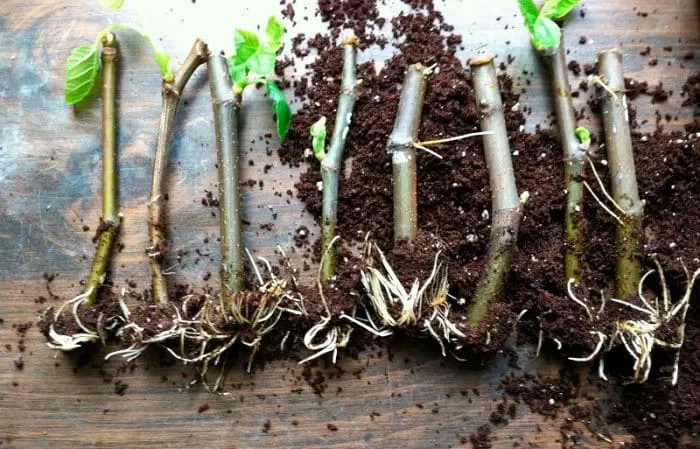
Hardwood cuttings have firm but flexible bark. When cut, they should show a green layer underneath. Avoid old or dry branches, as well as any with damage or disease.
Cut branches into 15–25 cm sections, each with at least three buds. Make the lower cut at a 45° angle and the upper cut straight.
Store the cuttings in a cool place. If you have a cellar, bury them in boxes of sand (sterilized with boiling water or baking in the oven at 180°C for 30–40 minutes).
Keep the cuttings at +1…+5°C. Moisten the sand lightly once a month to prevent drying.
Tip: If no cellar is available, store cuttings in the fridge wrapped in damp cloth.
In March, prepare the cuttings for planting. Trim the lower end by 1.5–2 cm and make shallow 1.5 cm vertical cuts in the bark (without damaging the green layer).
Note: Hardwood cuttings root in 45–60 days.
Green Cuttings
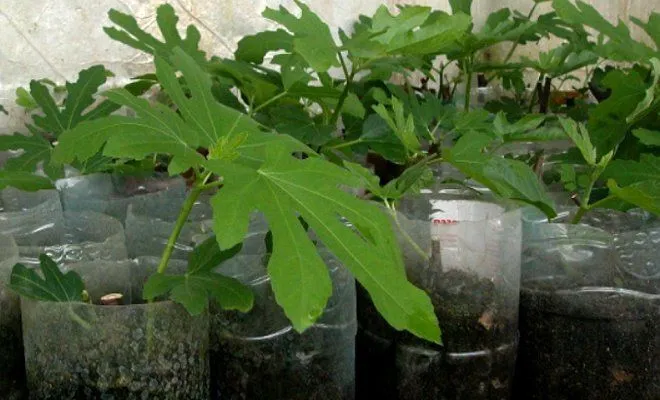
Take green cuttings in spring. Choose healthy, undamaged shoots with at least 3–4 buds. Cut at a 45° angle.
After cutting, a milky sap will ooze out. Let the cuttings sit for 6–8 hours until the sap flow stops.
Keep them in a cool, dark place for 4–6 hours. Make shallow bark incisions before rooting. Green cuttings develop roots in 1.5–2 months.
Note: Bark incisions encourage faster root development.
Preparing Cuttings
Both hardwood and green cuttings require preparation before planting. Follow these steps:
- Disinfection. Soak cuttings in a light pink potassium permanganate solution for an hour (focus on the cut ends).
- Rooting hormone. Dip cuttings in a rooting stimulant (such as Clonex or Rhizopon) for 30–40 minutes (green cuttings) or 1.5–2 hours (hardwood).
- Cut treatment. Dust the cut ends with wood ash or powdered charcoal.
After treatment, the cuttings are ready for rooting.
Rooting Methods
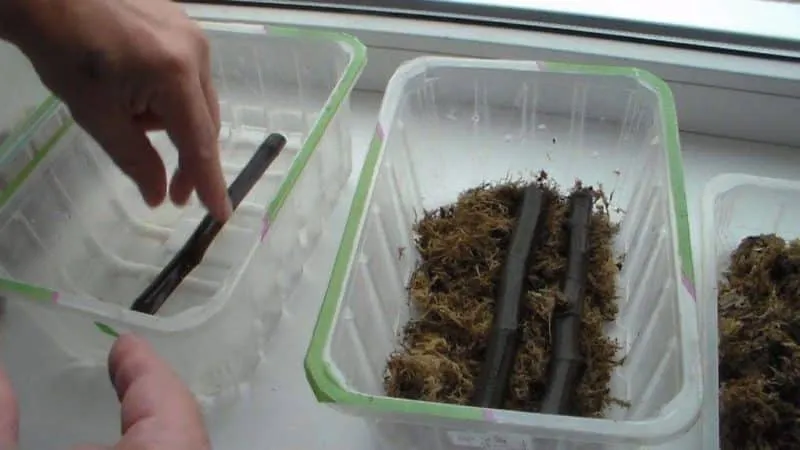
Several methods can be used to root fig cuttings:
- Sand. Sterilize sand with boiling water or baking. Fill a plastic cup with sand, insert the cutting 3 cm deep, and cover with a plastic bag or bottle. Ventilate daily for 15 minutes. Keep the sand moist. Remove the cover only after rooting.

- Water. Place cuttings in 3 cm of warm water (or water-soaked cotton). Add water as needed. A rooting hormone can speed up the process.
- Potting mix. Mix garden soil, compost, sand, and peat (2:2:1:1). Sterilize before use. Add drainage (gravel, perlite) to the pot, then fill with soil. Plant the cutting 3 cm deep, firm the soil, and top with sand. Cover with plastic and ventilate daily.
Cuttings rooted in water or sand should be transplanted into soil immediately after rooting. Those started in soil can wait until roots fill the pot.
New leaf growth indicates successful rooting.
If planting outdoors, grow the sapling indoors or in a greenhouse for a year first. Transplant only when the root system is well-developed.
Planting
Planting methods differ depending on whether figs will grow in pots or outdoors.
In Pots
 If rooted in water or sand, transplant cuttings into pots once roots form. If started in soil, repot when roots outgrow the container.
If rooted in water or sand, transplant cuttings into pots once roots form. If started in soil, repot when roots outgrow the container.
Indoor figs eventually need a 6–8 L pot.
How to pot a fig tree:
- Add drainage (5 cm) and some soil to a sterilized pot.
- Remove the fig from its old pot, keeping the root ball intact.
- Transfer to the new pot and fill gaps with soil.
- Water thoroughly.
Outdoors
Two outdoor planting methods exist: trench and hole planting.
Trench method:
- Dig a 1 m deep trench. The north side should be vertical (85–90°), while the south side slopes gently (30°) for better sun exposure.
- Dig 40–60 cm deep holes (1 m apart). Mix excavated soil with 2 kg compost, 30 g superphosphate, 20 g potassium sulfate, 1 cup ash, and 5 kg sand.
- Add 5 cm drainage (gravel, brick). Place the sapling in the hole with its root ball.
- Backfill with soil, firm, and water. Mulch with straw or peat.
- Reinforce trench walls with clay and crushed brick.
Hole method:
- Dig an 80 cm deep, 50 cm wide hole. Mix soil with 8 kg manure and 200 g NPK fertilizer.
- Add 5–10 cm drainage, then 15 cm of soil mix.
- Plant the sapling, backfill, and firm the soil.
- Water and mulch.
Aftercare
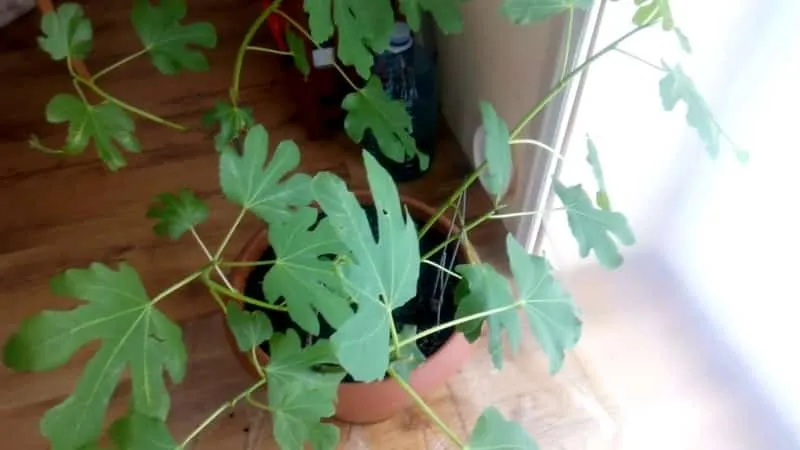
First-year care for young fig trees:
- Watering. Water daily in hot weather (10 L per plant). Reduce to twice weekly in cooler conditions.
- Weeding. Loosen soil after watering and remove weeds to prevent disease.
- Fertilizing. Feed every two weeks with diluted manure or ammonium nitrate.

- Disease prevention. Spray with a copper sulfate solution (1 tbsp per 10 L water) in spring and autumn.
- Winter protection. In autumn, remove fallen leaves, bend the tree down, cover with plastic, soil, and mulch. Add snow if possible.
Pruning isn’t necessary in the first year.
Conclusion
Propagating figs from cuttings is the most efficient method, yielding many new plants from pruned branches. Cuttings root quickly, grow well, and retain parent plant traits.
Figs can be grown both indoors and outdoors. The rooting process is simple, making it ideal for beginners.







